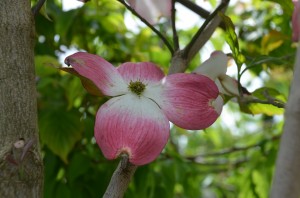Flowering dogwood (Cornus florida) is the most beautiful of U.S. native flowering trees (USDA hardiness zones 5 to 9). It typically grows 15-30 feet tall, but larger forms are known. The tree is broadly-pyramidal at a young age, branching is low, and matures with a rounded canopy. Spring bloom time usually overlaps with redbud (Cercis canadensis) which are finishing up. In 99.99% of the time, seedling dogwoods produce four petal-like white bracted flowers that measure 3-4 inches across.
‘Cherokee Brave’ produces dark pink bracts. Many texts describe the flowers as “dark red”. Pink color tones may not be as vivid if the spring weather is unseasonably hot or the tree is growing in warm southern climes. Cherokee Brave is a vigorous grower and bears flowers at an early age. The oval shaped leaves, 3-6 inch long, emerge with a slight reddish tint, and mature dark green by late spring. Foliage takes on intense shades of red, burgundy and purple in autumn before abscising.
Flowering dogwood is a popular small spring flowering tree in the northeast and mid-South regions of the U.S. Troubles with two fungus diseases, anthracnose and powdery mildew, has caused it to fall out of favor. Cherokee Brave exhibits above average resistance to both diseases, particularly the latter. Flowering dogwood is utilized as a specimen or small grouping on residential, parks, and commercial properties.
Plant flowering dogwood in an average well-drained soil and in full sun to part shade. For long life, it prefers a moist, organically rich, acidic soil in partial sun. The tree benefits from 2 – 4 inches of mulch to keep tree roots cool and moist during the summer. Following a 2- year establishment timeline, flowering dogwood exhibits good drought resistance.
Flowering dogwood’s brightly red drupe fruits are relished by birds and 4-legged creatures in the forest including deer. Their flowers attract numerous early arriving springtime butterflies. Its rugged alligator hide bark and branching silhouette are special winter features.


 Posted in
Posted in 
